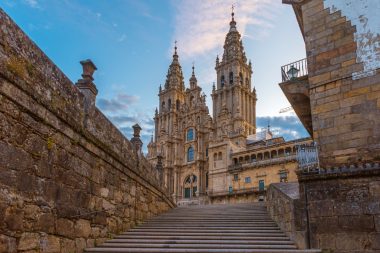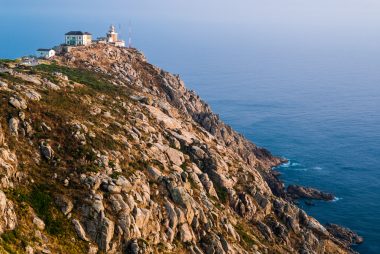
The region of Galicia, in the northwest of the Iberian Peninsula, belongs to Spain, but it is very different. Instead of fiesta, paella and flamenco, the region captivates with its naturalness: rough coasts, ancient villages and wide forests characterize the picture. The few large cities are a lively contrast. Galicia is best known as the destination of the Camino de Santiago. But the area also offers picturesque landscapes and places steeped in history in many other places.
Sea and originality
Galicia is characterized by the sea. The approximately 1,500-kilometre-long coastline offers an interesting mix of steep cliffs and long sandy beaches. A special feature are the many fjord-like bays, which are called Rías here. The Rías Baixas in the south invite you to swim with shallow water, while the northern Rías Altas impress with their high rock walls. There are numerous small fishing villages along the entire coast. Fishing and mussel farming still serve as a livelihood for many people here. Countless wooden rafts on which the mussels grow bear witness to this.
The interior of the country also shows itself originally. In the small villages, the stone houses covered with slate stand out. They often have a grain or corn store, the Hórreo, as an outbuilding. Away from the villages, extensive forest stands dominate the landscape. In the east of Galicia, the high mountains of the Cordillera Cantábrica represent the natural border with the rest of Spain.
The climate and cuisine are as varied as the landscape. Due to its location on the Atlantic Ocean, there is a lot of rain, wind and fog. This is reminiscent of other coastal regions of Western Europe such as Brittany. The cuisine is dominated by fish and seafood, which is unparalleled in freshness and variety. Mussel lovers in particular will get their money’s worth. Mussels, scallops, razor clams, barnacles, oysters – here you will find everything your heart desires. The fields also contribute to the cuisine. Galicians are proud of their regional potatoes, corn and cheese. An insider tip is the popular regional white wine Albariño.
By the way, many people in the autonomous region still speak Galician in everyday life. But the vast majority of locals can also communicate well in Spanish or other languages.
Galicia: Lively cities with a long history

The cities of Galicia form a counterpoint to the otherwise rather rural character. There you will find imposing cathedrals, lively promenades and renowned universities.
The Galician capital Santiago de Compostela is the terminus of the popular Way of St. James. There the pilgrims pick up their pilgrimage certificate in the cathedral. The church, like the lively old town, is a World Heritage Site. The port city of A Coruña is also buzzing with life. The extensive beach promenades are excellent for strolling. The city’s landmark, the Tower of Hercules, dates back to Roman times and is the oldest lighthouse in the world still in operation.
Another Roman building is the more than two-kilometre-long city wall in Lugo. Its gates and towers fit impressively into today’s cityscape. The city of Ourense was also founded by the Romans. They already used the hot springs that still bubble up from the ground all over the area today. Some of the thermal springs are located in the Park As Burgas in the center of the city.

One of the most beautiful Spanish cities is Pontevedra. The town is picturesquely situated on the banks of the Ría de Pontevedra. The historic town houses and arcades as well as the many cosy squares and narrow streets transport the visitor to another time. Nearby is Vigo, the largest city and economic center of Galicia. The old fishermen’s quarter of O Berbés and the fortress of O Castro are worth seeing. Those who climb the hilltop site will be rewarded with beautiful views of the city and the Ría de Vigo.
Dream beaches and Celtic villages
Away from the cities, there are countless places in Galicia that are worth a visit. For example, off the coast of Vigo lies the enchanting archipelago of Illas Cíes. These uninhabited islands were called “islands of the gods” by the Romans. Seabirds, dolphins and whales cavort there. The more than one kilometre long dream beach Praia de Rodas attracts with white powder sand. If you like it a little more sporty, you can admire the natural paradise on one of the marked hiking trails. As the number of visitors to the islands is limited, it is advisable to obtain permission for access well in advance.

At Cape Fisterra and the nearby beach of Langosteira, the Atlantic Ocean shows its rough side. The stretch of coast is called Costa da Morte (Coast of Death) because many ships used to crash between storms and cliffs there. Fisterra is considered the unofficial end of the Way of St. James. Many pilgrims still walk the approximately 100 kilometers from Santiago de Compostela to the Cape. With this section and the official part, the Camino de Santiago passes through Galicia for a total of a good 250 kilometres. If you want to avoid the crowd of pilgrims, you will find many alternatives. The various side routes of the Camino de Santiago are much quieter and just as interesting. The O Camiño dos Faros hiking trail along the coast or a tour through the Ribeira Sacra wine-growing region also offer beautiful views.
In many places, Galicia shows its millennia-old history. The oldest testimonies are the dolmen stone tombs from prehistoric times, which are scattered throughout the region. The foundation walls of the old Castro villages, such as the well-preserved complexes in A Guarda and Castro de Rei, date from the settlement by the Celts. The stone village of O Cebreiro, located on a ridge at the beginning of the Galician Way of St. James, is also impressive. This town of only 100 inhabitants exudes a magical atmosphere with its Celtic huts (pallozas) and the pre-Romanesque church. This also applies to the extensive Oseira monastery complex in the centre of Galicia. It combines architectural styles from Romanesque to Baroque and is known as the Galician El Escorial because of its size.
Diverse experiences for all tastes
Hiking along famous paths or off the beaten track, relaxing on deserted beaches, excursions into an ancient history and lively cities – Galicia convinces with incredible diversity. The region between the sea and the mountains offers breathtaking nature and testimonies of the past at every turn. Excellent seafood cuisine and down-to-earth people make the experience perfect. So the trip to Spain’s green northwest will be remembered positively for a long time.

